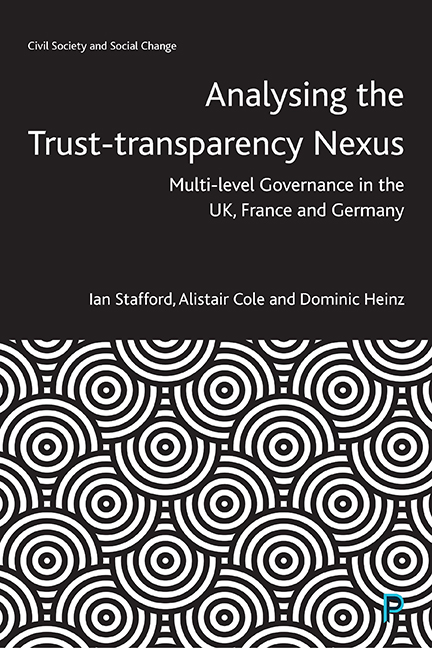Book contents
- Frontmatter
- Dedication
- Contents
- List of figures and tables
- List of abbreviations
- About the authors
- Acknowledgements
- Introduction
- 1 Building trust in an age of transparency
- 2 The trust–transparency nexus
- 3 Comparing cases
- 4 UK: North West England and Wales
- 5 Germany: Hesse and Saxony-Anhalt
- 6 France: Auvergne-Rhône-Alpes and Bretagne
- Conclusion: reflections on the trust–transparency nexus
- Appendix: qualitative fieldwork guide
- References
- Index
2 - The trust–transparency nexus
Published online by Cambridge University Press: 15 September 2022
- Frontmatter
- Dedication
- Contents
- List of figures and tables
- List of abbreviations
- About the authors
- Acknowledgements
- Introduction
- 1 Building trust in an age of transparency
- 2 The trust–transparency nexus
- 3 Comparing cases
- 4 UK: North West England and Wales
- 5 Germany: Hesse and Saxony-Anhalt
- 6 France: Auvergne-Rhône-Alpes and Bretagne
- Conclusion: reflections on the trust–transparency nexus
- Appendix: qualitative fieldwork guide
- References
- Index
Summary
In the previous chapter, trust was defined as much by its linkage with other concepts as by its own inherent properties. This is especially the case with trust and transparency, the core relationship we explore in this book. Rather than straightforward explanations in terms of independent, intermediary and dependent variables, we present trust as a contextually and institutionally contingent phenomenon based on the perceived competence and, to a lesser extent, benevolence and honesty of government and other actors within governance networks. What we label as the trust– transparency matrix presents a general heuristic, which facilitates carrying out cross-national multi-level comparisons of trust and transparency. The chapter is divided into four sections. The first examines contemporary approaches to defining and conceptualising transparency. The second explores the range of existing approaches to studying transparency within contemporary research. The third section examines the trust– transparency nexus, and existing studies designed to explore the link between increased transparency and levels of trust. The final extended section introduces the trust– transparency matrix, drawing on the debates explored in the current and previous chapters, which will be operationalised in the second section of the book.
Conceptualising transparency
Transparency, as Hood (2006: 3) notes, has ‘attained a quasi-religious significance’ over recent decades and this is reflected in the increasingly wide-ranging literature examining this concept, its rise to prominence and its potential consequences (Oliver, 2004; Hood and Heald, 2006; Fung et al, 2007; Bowles et al, 2014; Han, 2015; Schudson, 2015; Taylor and Kelsey, 2016; Fenster, 2017; Alloa and Thomä, 2018; Pozen and Schudson, 2018). Although the broader concept of transparency predates the late twentieth century, much like the concept of trust explored earlier in the book, transparency in the contemporary context is a multifaceted and contested concept that has risen to prominence in the past two decades (Heald, 2006; Mabillard and Pasquier, 2016). Cucciniello and colleagues’ (2017) review of the transparency literature notes that it has been defined and operationalised in a variety of different ways. Similarly, Alloa (2018: 29– 30) identifies ten different aspirations attributed to transparency in different contexts:
1. ‘Transparency as accessibility: Ensuring informational access to all citizens and implementing a “right to know.”’
2. ‘Transparency as procedural fairness: Safeguarding due process to all parties involved.’
- Type
- Chapter
- Information
- Analysing the Trust-Transparency NexusMulti-level Governance in the UK, France and Germany, pp. 25 - 42Publisher: Bristol University PressPrint publication year: 2022

